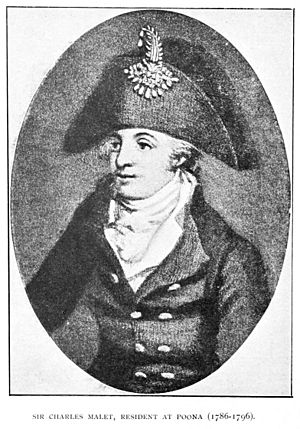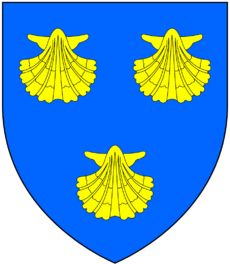Sir Charles Malet, 1st Baronet facts for kids
Sir Charles Warre Malet, 1st Baronet (born 1752, died 1815) was an important British diplomat. He worked for the British East India Company. His job was to be a "Resident" in the court of the Peshwa rulers of the Marathas in India. A Resident was like an ambassador, representing British interests.
Contents
Early Life and Career
Charles Warre Malet was born on December 30, 1752. He was the oldest son of Alexander Malet and his wife Ann. His father was a rector, a type of church leader, in Combe Florey, Somerset, England.
Malet started his career in India in 1774. His first important job was in Cambay, a city in India. He worked there for the Mughal emperor until 1785.
Becoming a Resident
In 1785, Charles Malet was given a very important role. He was appointed the Resident to the court of the Peshwas of Mahratta. This meant he lived and worked directly with the Maratha rulers. He even built a large house in a beautiful park outside the city of Poona (now Pune).
Malet's Role in India
Malet believed that western India was very important for British trade. He thought it could help improve trade with China. He also felt it was important for Britain to have more influence over the rulers in western India.
Forming Alliances
A major event happened in 1789 when Tipu Sultan, a powerful ruler, attacked Travancore. To deal with this, Cornwallis, a British leader, decided to form an alliance. Through Malet, the British made a treaty with the Nizam of Hyderabad and the Peshwa of the Marathas.
This treaty was difficult to arrange. Tipu Sultan was also trying to make alliances with the Maratha Peshwas. But Malet's efforts helped secure the agreement for the British.
Achievements and Later Life
For his hard work and success in forming this important alliance, Charles Malet received a special honor. In February 1791, he was made a baronet. This is a hereditary title, like a knight, but it can be passed down in the family.
Return to England
Malet left India in 1798. After returning to England, he married Susanna Wales. Susanna was the daughter of a famous painter named James Wales.
Even after leaving India, Malet remained interested in the country. He encouraged Thomas Daniell, another artist, to publish paintings of the famous caves at Ellora. Malet also wrote about these caves himself.
He was recognized for his knowledge and contributions. He became a Fellow of the Royal Society and the Society of Arts. These are important groups that promote science and arts.
Malet's Family
Charles and Susanna Malet had eight children together. Several of their children later served in India, following in their father's footsteps:
- Sir Alexander Malet, 2nd Baronet (1800 – 1886)
- Lt Col Charles St Lo Malet (1802 – 1889)
- William Wyndham Malet (1803 – 1885)
- Lt Col George Grenville Malet (1805 – 1856)
- Arthur Malet (1806 – 1888)
- Hugh Poyntz Malet (1808 – 1904)
- Octavius Warre Malet (1811 – 1891)
- Alfred Augustus Malet (1814 – 1898)
Malet also had other children from a relationship in India. Their portraits were painted by James Wales, his father-in-law.
Malet lived in Wilbury House in Wiltshire, England. This country house was designed by William Benson. Sir Charles Warre Malet passed away on January 24, 1815. His title of baronet was then passed to his son, Alexander.
Images for kids
-
Sir Charles Warre Malet's string of racehorses at exercise in 1800, by Francis Sartorius




